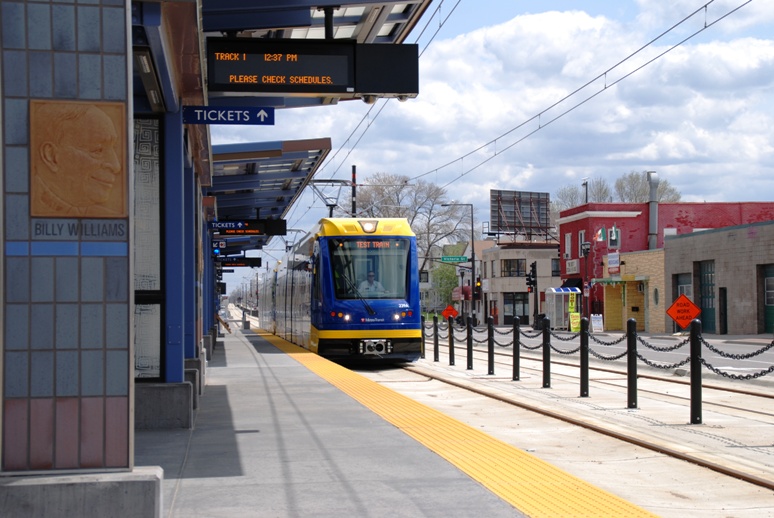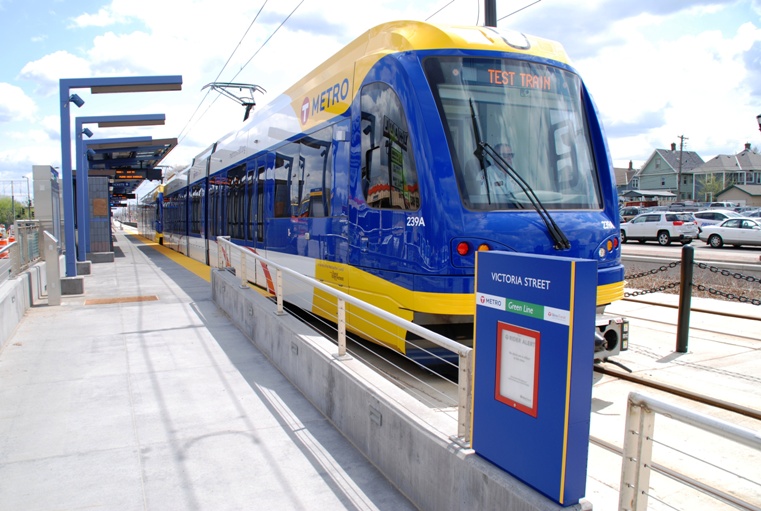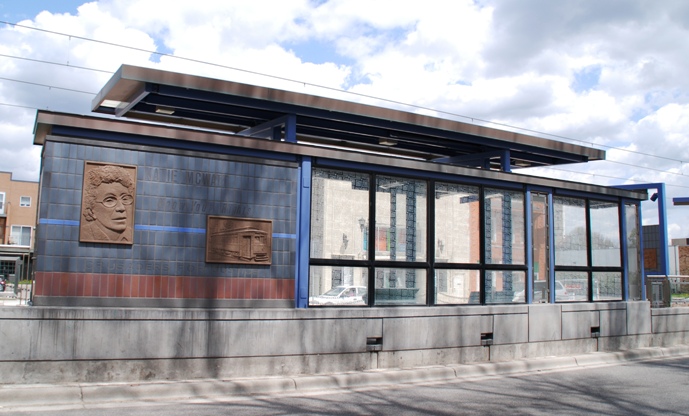 Sam Hayat opened his first car repair shop on University Avenue nearly 30 years ago. After struggling to sustain the business, he tried making a go of it at locations in south Minneapolis, Bloomington and Brooklyn Park.
Sam Hayat opened his first car repair shop on University Avenue nearly 30 years ago. After struggling to sustain the business, he tried making a go of it at locations in south Minneapolis, Bloomington and Brooklyn Park.
A year ago, he returned to the place where it all began, opening the doors to Eco Garage at the northwest corner of University Avenue and Victoria Street and just north of the METRO Green Line’s Victoria Street Station.
After years of bouncing around, it appears Hayat has finally hit the sweet spot.
“We’ve been busy since day one,” Hayat said recently. “It’s been a huge difference as far as business goes. This is really beyond my expectations.”
Hayat, who has expanded from one to four mechanics since opening in 2013, is expecting things to get even better after the Green Line opens on June 14. His thinking is that customers who need to leave their cars for the day will come to Eco Garage because of its convenient location on the Green Line.
Business owners and community leaders say Hayat’s success is a precursor of what is to come for those who live and work near Victoria Street Station. In addition to increased mobility and improved conditions for small businesses, light-rail is viewed as a catalyst for residential, commercial and retail development, as well as a springboard for community building.
One of the groups leading the charge is Model Cities, a nonprofit human service and community development group that has been active on University Avenue for nearly 50 years.
Based just north of Victoria Street Station, Model Cities hopes to begin construction in 2015 on two sites at or near Victoria Street Station, together known as Model Cities Redevelopment. The Model Cities BROWNstone and Central Exchange projects would together bring 60 new units of family and workforce housing as well as two new pocket parks, public art and a reading room that focuses on the role African Americans played in St. Paul’s early railroad industry.
Dr. Beverly Oliver Hawkins, the chief executive officer at Model Cities, said the project is part of a larger goal to develop and promote a distinct cultural district that celebrates the area’s history and the mix of cultures that now reside there.
“The window of opportunity has opened up and we are jumping through it,” Hawkins said.
Community leaders driving to restore the Victoria Theater also see the Green Line’s opening as a seminal moment for their efforts. Located just north of Victoria Street Station on University Avenue, the 1915 theater was a popular community hangout through the 1930s, when it was converted to retail use.
 After nearly 20 years of vacancy, the Victoria Theater Arts Initiative is working to purchase the building and re-open it as a community arts center. The theater is one of several locations where community celebrations will be held for the Green Line’s opening and will continue to feature art from the community throughout the year.
After nearly 20 years of vacancy, the Victoria Theater Arts Initiative is working to purchase the building and re-open it as a community arts center. The theater is one of several locations where community celebrations will be held for the Green Line’s opening and will continue to feature art from the community throughout the year.
Tyler Olson, who lives nearby and is involved in the restoration effort, said having light-rail trains run outside the theater’s doors will be critical to building interest in the site.
“This is probably something that could move forward without light rail, but having that adds a real depth of audience and allows us to share a lot more easily,” he said. “This could be a community center in a very traditional sense but now it will be open to a huge number of people from across the Twin Cities.”
Mary Milton, the owner of Transformation Salon, is also hoping the extra attention will be a boon for her nine-year-old business, located on University Avenue just west of Victoria Street Station. While the construction period was difficult, she believes the future will be much brighter.
If business improves as she expects, she wants to expand into a larger space and offer shoes, clothing, jewelry and other items.
“That was kind of my vision in the beginning,” she said. “I’m hoping that people will see the business and be encouraged to stop and get off.”
The renewed entrepreneurial spirit reflects a deep-seeded culture of self-reliance in the area surrounding the station.
MK Nguyen grew up in Frogtown as the daughter of Vietnamese refugee immigrants who became pioneers in the Southeast Asian small business community, opening Ala Francaise Bakery, the Twin Cities’ first bánh mì shop. As community leaders, they helped many others establish small businesses on University Avenue and St. Paul.
Nguyen now hopes to build on that legacy by opening a retail space of her own. She also wants to help grow the capacity of residents and business owners to work together and build a "healthy, wealthy, vibrant Frogtown for the next generation." The Green Line is an integral part of that vision, creating new opportunities for residents and youth to engage and develop a healthy, participatory, and sustainable model for social and economic growth, she said.
“My mind is blown every single day by the genius of the people in my neighborhood," Nguyen said. "My goal is to unleash the human potential that already exists in Frogtown, invite others to join our story, and add to the rich and dynamic history embedded in Frogtown.”
While focused on the future, residents around the station remain ever-mindful of the neighborhood’s history. The historic Rondo community was divided by the construction of Interstate 94, and that past experience remains front of mind for many who still live in the area.
To recognize the leaders who held the neighborhood together throughout the years, the Victoria Street Station features 17 images of people who have impacted the community. The group includes educators, historians and entrepreneurs, such as Tiger “Jack” Rosenbloom who ran a small shop at the corner of St Anthony Avenue and Dale Street and is remembered for saying “Never say can’t.”
Sculptor Foster Willey learned about the individuals while crafting the station artwork and said he was struck by the number of strong personalities that called St. Paul home.
“There is a very compelling story of a very vibrant community that had some rough times and their resilience in overcoming that while continuing to thrive and celebrate their history and culture,” he said.
 Victoria Station At a Glance
Victoria Station At a Glance
Connecting bus routes: Route 16, which will provide local service on University Avenue between Stadium Village Station and downtown St. Paul.
Public art: Minneapolis artist Foster Willey partnered with his brother Guy to sculpt portraits of historic people and landmarks from the Rondo community which are affixed to the station walls. Around 80 individuals were nominated for inclusion in the “Faces of Rondo” project and community members helped select 17 people to include. Among those featured at the station is Gordon Parks, who overcame trying circumstances to become a well-regarded author, photographer and filmmaker. Others featured at the station are Pearla Mae Barnes, Lou Bellamy, Dorothea Burns, Charles Crutchfield Sr., Mahmoud El-Kati, Beverley Oliver Hawkins, Katie McWatt, Debbie Montgomery, Rhoda Stroud, Billy Williams, Floyd Massey Jr., Sharon Sayles Belton, Tiger Jack Rosenblum, Hallie Q. Brown and Evelyn Fairbanks. There are also images of the Rondo-Stryker streetcar, a familiar sight in the neighborhood from the 1920s to the 1950s; Mechanic Arts High School, a fixture in the community until it closed in 1976; and Pullman porters. Many early African American Rondo residents worked on sleeping cars as Pullman porters, and fromed the first all-black union. Learn more.
Area landmarks: Ryan Park, Carty Park, Frogtown Park and Farm, Maxfield Elementary
Bike-ped connections: A NiceRide kiosk is located in the northwest corner of University Avenue and Victoria Street. This summer, St. Paul will construct a bike boulevard on Charles Avenue between North Aldine Street and Park Street. There are pedestrian crossings over I-94 at Chatsworth and Grotto streets.
Neighborhood groups: Frogtown Neighborhood Association; Summit University Planning Council